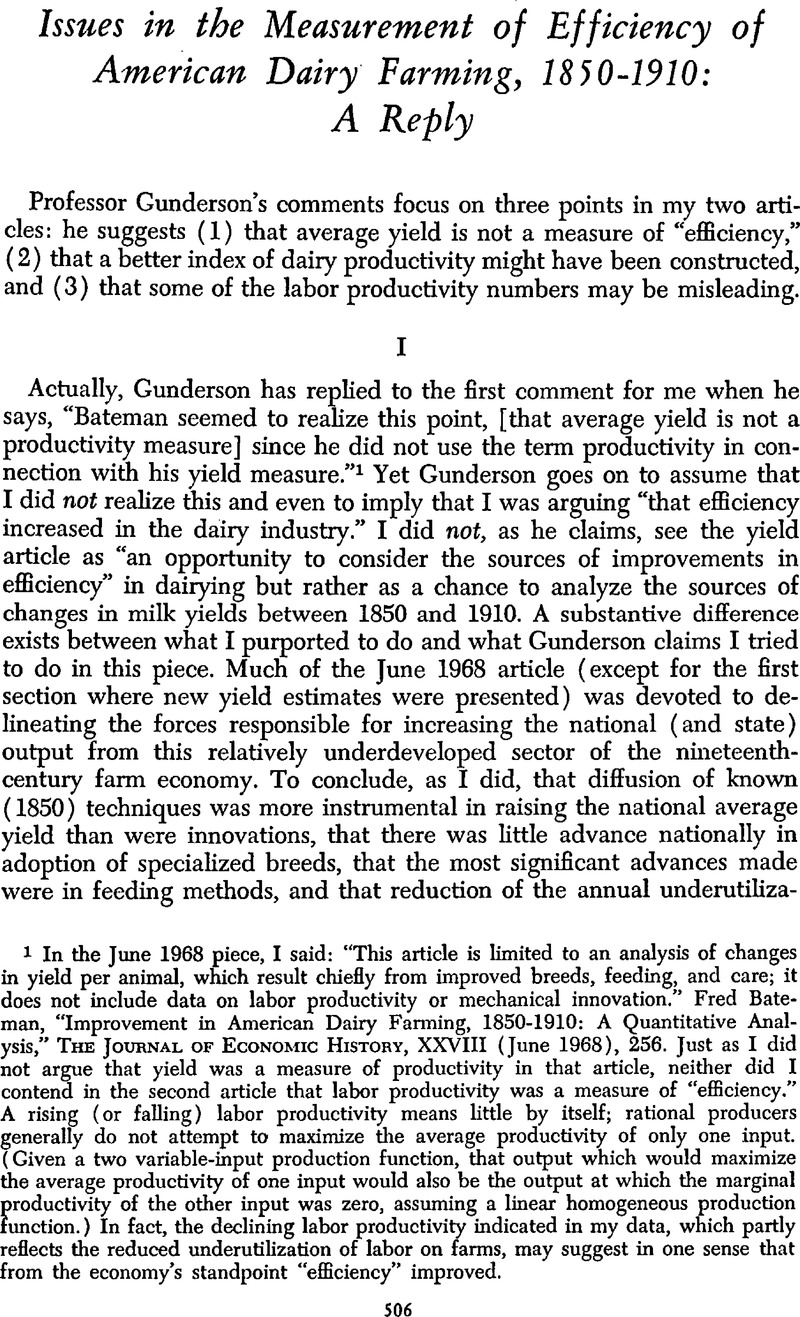No CrossRef data available.
Article contents
Issues in the Measurement of Efficiency of American Dairy Farming, 1850–1910: A Reply
Published online by Cambridge University Press: 03 February 2011
Abstract

- Type
- Notes
- Information
- Copyright
- Copyright © The Economic History Association 1969
References
1 In the June 1968 piece, I said: “This article is limited to an analysis of changes in yield per animal, which result chiefly from improved breeds, feeding, and care; it does not include data on labor productivity or mechanical innovation.” Bateman, Fred, “Improvement in American Dairy Farming, 1850–1910: A Quantitative Analysis,” The Journal of Economic History, XXVIII (June 1968), 256.Google Scholar Just as I did not argue that yield was a measure of productivity in that article, neither did I contend in the second article that labor productivity was a measure of “efficiency.” A rising (or falling) labor productivity means little by itself; rational producers generally do not attempt to maximize the average productivity of only one input. (Given a two variable-input production function, that output which would maximize the average productivity of one input would also be the output at which the marginal productivity of the other input was zero, assuming a linear homogeneous production function.) In fact, the declining labor productivity indicated in my data, which partly reflects the reduced underutilization of labor on farms, may suggest in one sense that from the economy's standpoint “efficiency” improved.
2 Bateman, “Improvement,” fnn. 18 and 22.
3 Since Gunderson does not elaborate on his suggestion for measuring total productivity by “weighting the productivity change of each input by its relative contribution to cost,” I will not comment on it here.
4 Prices received by Wisconsin farmers for butter and cheese rose about 20 percent between 1850–59 and 1900–09, a period during which the general wholesale price index declined approximately 9 percent. I have deliberately chosen data for prices paid to farmers, a choice that would most favor Gunderson s proposal. Use of prices paid by consumers, for example, would further weaken this method, since it would introduce the influence on price of transport, distribution, and other services provided by firms not purely competitive, making it impossible even to assume that dairy prices reflected the actions of a purely competitive industry.
5 Gunderson's argument would also be valid if we could assume not economy-wide pure competition, but equal degrees of competitive imperfection throughout the economy.
6 See Maxwell, W. David, “Short-Run Returns to Scale and the Production of Services,” The Southern Economic Journal, XXXII (July 1965), 1–14.CrossRefGoogle Scholar
7 Although successful machine-milking was not developed until the early twentieth century, I wish to avoid here the question of whether factor availability affected invention or the direction of technology and the counterfactual interrogative of whether feasible machine-milking technology would have come more quickly had factor costs been different. There is speculation in my labor article on this question, however, in fn. 7.
8 Fred Bateman, “Labor Inputs and Productivity in American Dairy Agriculture, 1850–1910,” The Journal of Economic History, XXIX (June 1969), p. 220.




